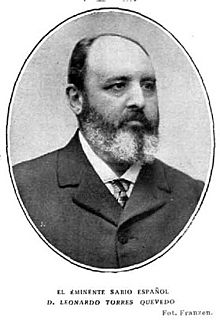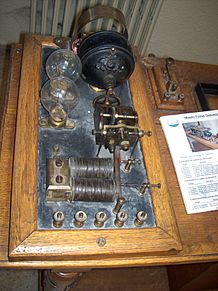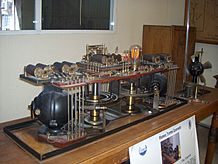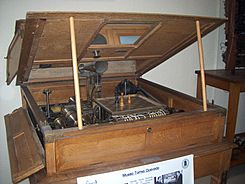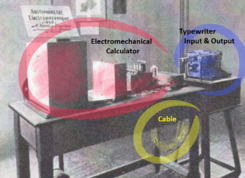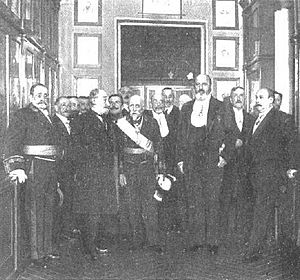Leonardo Torres Quevedo facts for kids
Quick facts for kids
The Most Excellent
Leonardo Torres Quevedo
|
|
|---|---|

Torres in 1917
|
|
| Born |
Leonardo Torres Quevedo
28 December 1852 Molledo, Spain
|
| Died | 18 December 1936 (aged 83) Madrid, Spain
|
| Nationality | Spanish |
| Education | Official School of the Corps of Civil Engineers |
| Occupation | Inventor, computer scientist, engineer, Esperantist |
| Years active | 1876-1930 |
| Known for | Introduce Floating-point arithmetic El Ajedrecista Telekino (Radio control) Analytical machine Astra-Torres airship Whirlpool Aero Car |
|
Notable work
|
Essays on Automatics (1913) |
| Awards | Civil Order of Alfonso XII (1906) Echegaray Medal (1916) Order of Charles III (1921) Legion of Honour (1922) Honorary doctorate (Sorbonne: 1923 - UC: 1925) Order of the Spanish Republic (1934) |
| Member of the Spanish Royal Academy of Sciences | |
| In office 19 May 1901 – 18 December 1936 |
|
| Seat N of the Royal Spanish Academy | |
| In office 31 October 1920 – 18 December 1936 |
|
| Preceded by | Benito Pérez Galdós |
| Succeeded by | Manuel Machado |
| President of the Spanish Royal Academy of Sciences | |
| In office 2 February 1928 – 31 October 1934 |
|
| Preceded by | José Rodríguez Carracido |
| Succeeded by | Blas Cabrera |
| Signature |  |
Leonardo Torres Quevedo (born December 28, 1852 – died December 18, 1936) was a brilliant Spanish engineer, computer scientist, and inventor. He was known for his many inventions in different fields like mechanics, flying machines, and automation. He was a pioneer in early computing, creating machines that could do calculations. He also developed radio control and built El Ajedrecista, a chess-playing machine. Torres Quevedo also made important contributions to airship design and invented a special cable car system.
Contents
Biography
Leonardo Torres Quevedo was born on December 28, 1852, in Molledo, Spain. His father was a civil engineer who worked on railways. Leonardo spent his childhood mostly in Bilbao, but also in Cantabria. He was often cared for by relatives, who later made him their heir. This helped him become independent later in life.
He went to high school in Bilbao and then studied in Paris for two years. In 1870, his family moved to Madrid, where he began studying engineering. He paused his studies in 1873 to help defend Bilbao during a war. After the war, he finished his degree in 1876.
After graduating, Torres Quevedo traveled through Europe. He visited Italy, France, and Switzerland to learn about the latest scientific and technical discoveries, especially in electricity. When he returned to Spain, he settled in Santander and began his own research. In 1885, he married Luz Polanco y Navarro, and they had eight children.
In 1889, he moved to Madrid and became very active in the city's scientific community. In 1901, he joined the Spanish Royal Academy of Sciences. He even became its president from 1928 to 1934. In 1907, the Athenæum of Madrid created the Laboratory of Applied Mechanics, with Torres Quevedo as its director. This lab focused on making scientific tools.
Torres Quevedo was recognized internationally for his work. In 1916, King Alfonso XIII of Spain gave him the Echegaray Medal. In 1920, he became a member of the Royal Spanish Academy and the Paris Academy of Science. He also received honorary doctorates from the Sorbonne in 1923 and the University of Coimbra in 1925. He received many other awards and honors throughout his life.
In the early 1900s, Torres Quevedo learned Esperanto, an international language. He believed it could help scientists from different countries communicate better. He even proposed that the League of Nations study the idea of an auxiliary language.
Leonardo Torres Quevedo passed away on December 18, 1936, in Madrid, just before his 84th birthday.
Amazing Inventions and Discoveries
Cableways and Cable Cars
Torres Quevedo started experimenting with cable cars very early. In 1887, he built his first cableway in his hometown of Molledo. It was about 200 meters (656 feet) long and could carry a single log seat pulled by cows. This led to his first patent for a "multi-wire aerial funicular road system." His design made cable cars much safer for carrying people, not just cargo.
A key part of his design was how the cables were supported. One end was fixed, and the other was attached to moving weights. This kept the tension in the cables constant, making them very strong. This design could even handle the failure of one support cable.
In 1907, Torres Quevedo built the first cable car for public transport in San Sebastián, Spain, on Mount Ulia. Since then, many other cable cars have been built using his ideas around the world, including in Chamonix and Rio de Janeiro.
His most famous cable car is the Spanish Aerocar at Niagara Falls in Canada. This cable car crosses the Niagara Whirlpool in the Niagara Gorge. It is 550 meters (1,804 feet) long and travels at about 7.2 kilometers per hour (4.5 mph). It was built between 1914 and 1916. A bronze plaque at the entrance mentions that it was designed by a Spaniard and built by a Spanish company. It opened to the public on August 9, 1916, and is still running today without any major accidents. It's a popular tourist attraction!
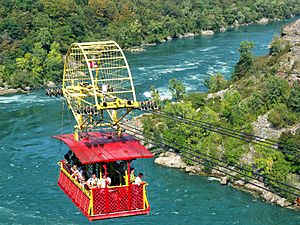
Analogue Calculating Machines
Torres Quevedo was also interested in calculating machines. In 1893, he wrote about his "algebraic machines." These machines used mechanical parts to solve mathematical problems. He showed how they could use turning disks to represent numbers and solve complex equations.
Between 1910 and 1920, Torres Quevedo built a machine that could solve algebraic equations with up to eight terms. It could even find complex roots with high accuracy. This machine used a clever system where angular movements were proportional to the logarithms of the numbers.
He also built a machine to solve second-order equations and an integrator. These machines are now kept in the "Torres Quevedo" Museum at the Technical University of Madrid.
Airships
In 1902, Torres Quevedo presented a new type of dirigible design. He solved a big problem by creating an internal frame of flexible cables. This made the airship rigid using internal pressure. He also made the balloon trilobed (three-lobed) for increased safety.
In 1904, he became the director of the Center for Aeronautical Essays in Madrid. In 1905, he helped build the first Spanish dirigible, named Torres Quevedo, for the Army Military Aerostatics Service. It had successful test flights. This led to a partnership with the French company Astra, which bought his patent. In 1911, they started building airships known as the Astra-Torres airships.
Torres Quevedo also designed a special "mooring mast" for airships in 1910. This was a metal column on the ground where an airship could be safely attached. This allowed airships to be moored outside, even in windy conditions. This design was patented in 1911 and 1912.
In 1913, the Astra-Torres XIV airship set a world speed record for airships, reaching 83.2 km/h (51.7 mph). The unique trilobed design was widely used during World War I by the Allied Powers for tasks like protecting convoys and hunting submarines.
In 1919, Torres Quevedo designed a transatlantic dirigible called Hispania. He hoped it would be the first to cross the Atlantic, but financial problems delayed the project. The British aviators John Alcock and Arthur Brown made the first non-stop transatlantic flight in a plane that same year.
Radio Control: The Telekino
Torres Quevedo was a pioneer in remote control. In 1903, he showed his invention, the Telekino, to the Paris Academy of Science. He also provided a detailed explanation and a live demonstration. The Telekino was patented in France, Spain, Britain, and the United States.
The name Telekino comes from two Greek words: tele (meaning "at distance") and kino (meaning "movement"). So, it means "movement at distance." He wanted to use it to test his airship designs without risking human lives.
The Telekino had three main parts: a wireless receiver, a multi-position switch, and two servomotors. It worked by sending signals as electric pulses. Each pulse would move the switch one step forward. When the switch reached a certain position, it would power a servomotor, causing a specific action. Torres Quevedo figured out how to use a sequence of pulses to create different commands.
In 1905, he tested the Telekino on an electric three-wheeled vehicle in Madrid. This was possibly the first radio-controlled unmanned ground vehicle. The same year, he tested a second model on a boat in a pond in Madrid, controlling it from up to 250 meters (820 feet away).
His most famous demonstration was on September 25, 1906, in the port of Bilbao. In front of King Alfonso XIII and a large crowd, Torres Quevedo successfully guided the boat Vizcaya from the shore, controlling it from over 2 kilometers (1.2 miles) away. He later tried to use the Telekino for torpedoes, but he couldn't get enough funding.
Chess Automaton: El Ajedrecista
In the early 1910s, Torres Quevedo built a chess-playing machine called El Ajedrecista (The Chessplayer). Unlike earlier chess machines that had a hidden human operator, El Ajedrecista was a true machine that could play chess on its own.
This machine could play a king and rook endgame against a human player's king. It didn't need any human help. The chess pieces had a metal mesh at their base. This mesh closed an electric circuit that told the machine where each piece was on the board. When the human player moved the black king, the machine would calculate and make the best move for the white player.
If the human player made an illegal move, the machine would light up a signal. If three illegal moves were made, the machine would stop playing. Many people consider this device to be the first computer game in history.
El Ajedrecista caused a lot of excitement when it was first shown at the University of Paris in 1914. Its design was even published in a magazine called La Nature. It was also featured in Scientific American in 1915.
A second, more advanced version was built by his son Gonzalo under Torres Quevedo's guidance. It was shown in Paris in 1922. This version used electromagnets under the board to move the pieces. It even had a voice recording that announced "checkmate" when the machine won!
At a conference in Paris in 1951, El Ajedrecista was shown to a wider audience. It even defeated Savielly Tartakower, who was a chess Grandmaster. This made him the first Grandmaster to lose a game against a machine.
Analytical Machines
Torres Quevedo's most important written work was "Essays on Automatics" (1913). In this paper, he introduced the idea of floating-point arithmetic, which is a way for computers to handle very large or very small numbers. He also described machines that could act intelligently, like humans, and adapt to changes in their environment.
He discussed Charles Babbage's earlier work on mechanical computers. Torres Quevedo showed that all the complex gear mechanisms of Babbage's machines could be made using electromechanical parts.
He proved his ideas with working models. In 1914, he showed an analytical machine that used a small memory made with electromagnets. In 1920, he presented his "Electromechanical Arithmometer" in Paris. This machine was connected to a typewriter. You could type commands on the typewriter, and the machine would calculate the answer and print it automatically. For example, you could type "532 x 257" and then "=" and it would print the result. This machine was not programmable, but it was a very early example of a computer with a keyboard input. Torres Quevedo had many ideas that were far ahead of his time.
Other Inventions
Torres Quevedo had many other inventions. He patented "Coordinate Indicators" (1900) to help people find their way in cities using mechanical signals. He also invented the "Dianemologo" (1907) for recording speeches without a stenographer. He designed "Deformable Fusiform Balloons" (1914) and "Railway interlocks" (1918) to protect train movements.
In 1913, he designed a "Camp-Vessel" to transport airships, where the mooring mast would connect the ship to the airship. In 1918, he built an innovative catamaran with a metal hull in Bilbao.
In his later years, Torres Quevedo focused on pedagogy (the art of teaching). He looked for machines that could help educators. From 1922 to 1930, he improved typewriters and created tools like the "Projectable Pointer" and the "Teaching Projector." The Projectable Pointer used a shadow as a pointer, allowing a speaker to highlight areas on a projected image. The Teaching Projector improved how slides were placed for projection.
Legacy
After Torres Quevedo passed away in 1936, his death went somewhat unnoticed due to the Spanish Civil War. However, important scientists like the French mathematician Maurice d'Ocagne praised his work.
In 1941, a large building was constructed in Madrid and named after him. This building became the Institute of Applied Physics, which is now the Institute of Physical and Information Technologies "Leonardo Torres Quevedo" (ITEFI). It focuses on designing instruments and researching mechanical, electrical, and electronic problems.
Torres Quevedo was not forgotten. In 1953, Spain celebrated the 100th anniversary of his birth with many events. In 1983, the "Leonardo Torres Quevedo National Research Award" was created to honor Spanish scientists.
In 2007, the famous Institute of Electrical and Electronics Engineers (IEEE) recognized the Telekino as a "Milestone in Electrical Engineering and Computing." This is a special honor for important achievements in these fields.
On December 28, 2012, Google celebrated his 160th birthday with a special Google Doodle on their homepage.
On August 8, 2016, the 100th anniversary of the Niagara Aerocar was celebrated. It has been running continuously without accidents, showing how well Torres Quevedo's designs worked. This celebration was part of the "Torres Quevedo Year 2016" to remember and honor his contributions.
Awards
- Grand Cross of the Civil Order of Alfonso XII (1906)
- Echegaray Medal (1916)
- Parville Award by the French Academy of Sciences (1916)
- Grand Cross of the Order of Charles III (1921)
- Grand Cross of the Military Order of Saint James of the Sword (1921)
- Commander of the Legion of Honour (1922)
- Honorary doctorate by the University of Paris (1923)
- Honorary doctorate by the University of Coimbra (1925)
- Grand-Cross Band of the Order of the Spanish Republic (1934)
Selected Works
- "A multi-wire aerial funicular road system" (1887)
- Memory about algebraic machines (1894)
- Calculating machines (1900)
- "Improvements in dirigible aerostats" (1902)
- "Means or method for directing mechanical movements at or from a distance" (1902)
- "Improvements in Mooring Arrangements for Airships" (1911)
- Essays on Automatics. Its definition. Theoretical extension of its applications (1913)
- Electromechanical Arithmometer (1920)
See also
 In Spanish: Leonardo Torres Quevedo para niños
In Spanish: Leonardo Torres Quevedo para niños
- Science and technology in Spain
- List of Spanish inventions and discoveries
- List of Esperanto speakers
- List of pioneers in computer science
- Timeline of artificial intelligence
- Timeline of computing hardware before 1950
- Aerial tramway
- Niagara Falls
- Radio control
- Remote control
- Unmanned aerial vehicle
- Unmanned ground vehicle
- Airship
- Astra-Torres airship
- Mooring mast
- Analytical Engine
- Analog computer
- Computer
- Computer science
- History of computer science
- History of computing
- History of artificial intelligence
- Robot
- History of robots
- Robotics
- Floating-point arithmetic
- El Ajedrecista
- Computer chess
- Mechanical Turk


